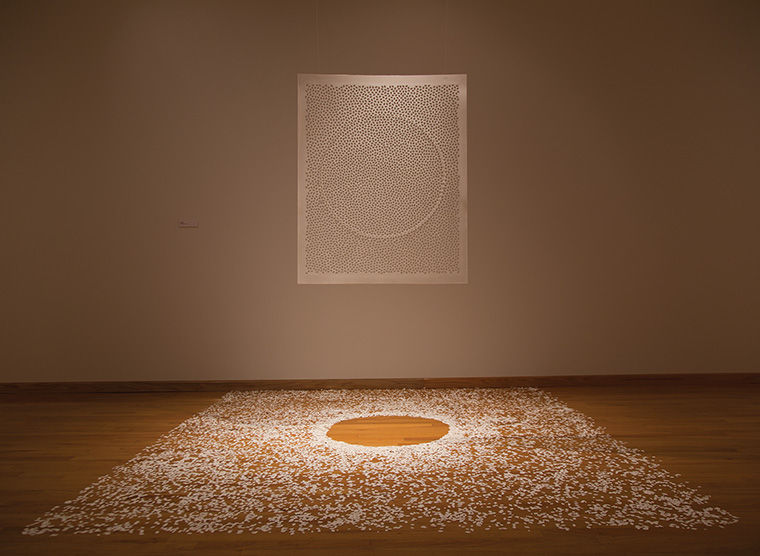Traveling exhibition ‘Papercuts’ opens at Columbia
September 22, 2014
“Papercuts,” a traveling paper art exhibition that has been to six cities, including Atlanta and Nashville, is making its last stop at Columbia.
The exhibition, organized by artist Reni Gower, opened Sept. 19 and is being held in the Glass Curtain Galley, 1104 S. Wabash Ave., by the Center for Book and Paper Arts as a part of the center’s 20th Anniversary.
Marilyn Propp, interim coordinator for exhibitions and programs at the Center for Book and Paper Arts, said “Papercuts” is about paper itself as a material. All the pieces in the gallery are intricate and labor intensive because every piece is cut by hand, she said.
“Papercuts” features seven international artists, many of whom are currently traveling around the world. Jaq Belcher, an Australian artist residing in New York City, is featured with her installation “Solace,” which is a meditative piece that includes a hanging component and about 19,000 seeds scattered on the floor, Propp said.
Other exhibitors include Daniella Woolf, whose pieces are collections of daily information such as newspapers, photos and Rolodex cards. Artist, Beatrice Coron based one of her pieces off the 1972 novel “Invisible Cities” by Italo Calvino, as she creates her own narrative, Propp said.
One of the most prominent pieces in the Glass Curtain Gallery is a floor-to-ceiling paper tornado displayed in the entryway, created by artist Lenka Konopasek, Propp said.
Michelle Forsyth, another artist in the exhibition and an associate professor of painting at OCAD University in Toronto, created punched-paper pieces in which she works with suffering and loss, Propp said.
Gower, the “Papercuts” exhibition organizer, created stencils modeled after Celtic Knot designs that she traced and cut with a box cutter, Propp said.
Gower said she started her work with cut paper while teaching in Glasgow, Scotland. She said she started making cutout patterns to make her drawings more visually complex. She said the exhibition took approximately a year to curate. Gower wanted all the work in the exhibition to be cut by hand rather than laser-cut, and as she chose artists, narrative and sacred geometry became additional components of the exhibition, she said.
“The act of cutting becomes a contemplative ritual that is embedded in the practice of the artists in the exhibition,” Gower said. “The celebration of work made by hand is an important component to this conversation. It offers an alternative perspective to the superficiality of social media, over-the-top spectacle and consumerism. It offers a reprieve or contemplative space to the viewer and to the maker.”
Lauren Scanlon, a Los Angeles-based artist, features large and small pieces made entirely out of pages from “Harlequin Present” novels sewn together with gold thread.
“When I was about 10, my maternal grandmother gave me a grocery sack of those same books,” Scanlon said. “1970’s ‘Harlequin Present’ [novels] have a really iconic cover, but I was interested in how they affected me as a 10-year-old and then also as an adult so I wanted to do something with the books.”
According to the exhibition catalogue, the pages are cut with patterns of old bedspreads Each work is named after the title of a book and feature a majority of the text, Propp said.
“That’s one thing that I’m not sure people realize was intentional,” Scanlon said. “They look at the paper cut overall as a design with out realizing that the words that are still readable will give you some kind of veiled information about what the books were about.”
Jaq Belcher, an artist who works strictly in paper cuts, said she gravitated towards it because she thought paper was beautifully simple on its own. She now creates meditative pieces with cut circle and
petal-shaped components.
“The repetition of it came from hanging around aboriginal artwork,” Belcher said. “Because I was in India before coming to New York, I was watching them do this practice of Japa [meditation] where they write the name of a god over and over again in a repetitious sort of mantra practice. So all of those things combined brought me to what I do today.”
Belcher said she thinks “Papercuts” is a powerful exhibit and is set to be displayed in Qatar next year.
“It’s a really nice cross-section of people who are using the same technique but in a diverse fashion,” Belcher said. “I’ve been a number of paper-cutting shows, and this one is really strong in its diversity.”








